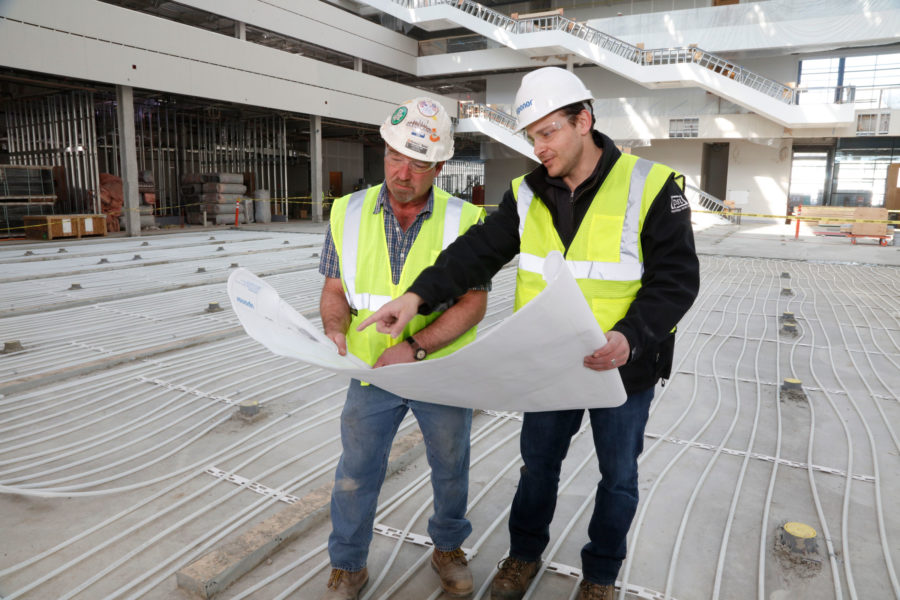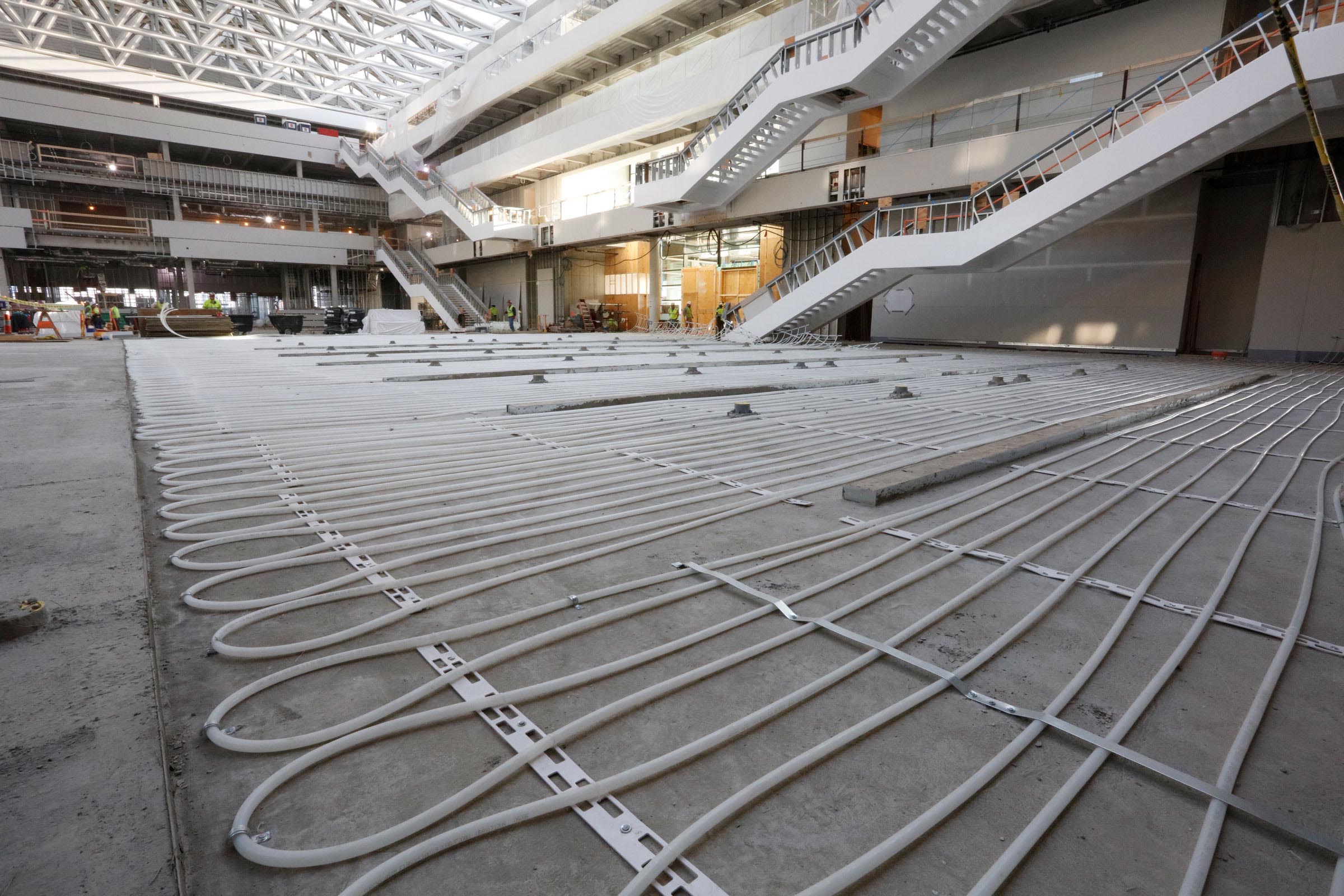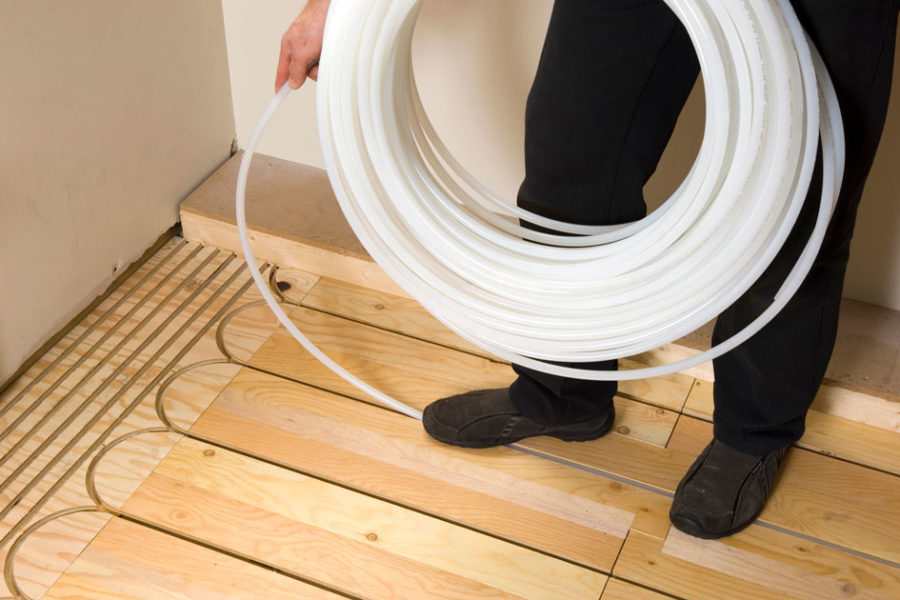Story at a glance:
- Compared to forced air, using hydronic radiant heating can create more comfortable and quiet settings.
- Increased energy efficiency is just one way how radiant heating promotes sustainability in buildings.
- There are several ways to install a hydronic radiant system depending on the structure itself.
When the global pandemic forced lockdowns across the country and many employees were mandated to work from home, it brought a new focus to the need for sustainability and indoor environmental quality (IEQ) in structures. This trend is bringing energy-efficient solutions, such as radiant floor heating, along with renewable energy sources, such as geothermal and solar, to the forefront.
Although hydronic radiant heating has been around for hundreds of years and has been the main form of heating homes throughout Europe for decades, the US has lagged behind in adopting this technology, with only about 4% of homes using hydronic radiant heat.
In addition to its extreme thermal comfort that keeps warmth close to the body, hydronic radiant heating is also exceptionally energy-efficient and helps promote a cleaner indoor environment with better air quality.
Here are four ways how radiant heating promotes sustainability and IEQ.
1. Cleaner indoor air

Photo courtesy of Uponor
In a hydronic radiant heating system, warm water flows through flexible plastic tubing embedded in a concrete slab or placed on top or underneath the subfloor. The warmth from the flowing water through the tubing radiates up from the floor to bring comfort to people in a space.
Because hydronic radiant heating systems use pumps to move water instead of fans or blowers to push air, the system does not circulate viruses, allergens, or odors throughout the indoor space.
In addition to benefits in air quality, hydronic radiant floor heating systems also do not require ductwork, so they provide greater architectural freedom for building design, including expansive ceilings with open spaces.
2. Quieter environments

Photo courtesy of Uponor
Traditional forced air HVAC systems and the ductwork associated with them can be noisy. Most people are familiar with the loud sounds of forced air equipment turning on and running to accommodate interior climate comfort. There is also the sound of the ductwork expanding and contracting as the hot air blows through the system and then cold air enters when the system is off.
Hydronic radiant floor heating is quiet. The water running through the tubing in the floors silently distributes warmth throughout a space without any noise. The mechanical-room parts—such as a boiler, pumps, manifolds, and actuators—also work quietly.
Best of all, radiant systems are practically maintenance-free. With the exception of occasional boiler maintenance, the rest of the system does not require any annual work. Traditional HVAC systems, on the other hand, need regular replacement of air filters and equipment tune-ups that can really add up over time.
3. Improved energy efficiency
Water has the capacity to transport energy 3,500 times greater than air. That means a hydronic radiant heating system that uses water to heat a space rather than air will be much more energy-efficient. This is especially important because heating and electricity generation accounts for nearly 25% of all greenhouse gas emissions.
Radiant is also more energy efficient because the heat stays near the floor where people are located. In a traditional forced air HVAC system, the hot air blows into a room and quickly rises up to the ceiling.
Additionally, people are more comfortable with a radiant floor heating system at a lower thermostat setting, such as 68°F, than with a forced air system at a higher thermostat setting like 72°F. Those four degrees can make a big difference in energy use over time.
Another benefit of radiant heating systems is the fact that they are installed in zones. This means occupants have a separate thermostat for each radiant-heated space. Not only does this provide custom comfort control when people are in a space, it also makes the system even more energy efficient because people can keep the heat low in spaces that are not in use.
Best of all, hydronic radiant floor heating systems can become even more energy efficient when paired with sustainable heat sources, such as geothermal and solar. These types of systems can potentially provide a structure with free heat, which is the best form of sustainable comfort.
4. Superior comfort

Photo courtesy of Uponor
Speaking of comfort, hydronic radiant floor heating systems are the most comfortable form of heat available. The reason radiant heat is so comfortable is because it most closely aligns with the ideal heating curve for the human body.
In fact, people in a radiant-heated space will actually feel warmer and more comfortable at a lower thermostat setting than people in a forced air space at a higher thermostat setting. This is because forced air HVAC systems are the most divergent from the ideal heating curve for the human body.
When forced air heat enters a room, it quickly heads to the ceiling, so people can’t keep an even heat near their bodies. Radiant heating, however, provides a consistent, even comfort that stays near the floor at all times.
Installing Radiant
- Photo courtesy of Uponor
Depending on the application, there are many different methods for installing a radiant heating system. For commercial applications, the tie-down method to wire rebar or the staple-down method to foam-board insulation is a typical installation for embedding the tubing in concrete slabs.
For residential applications with floors that have joists below, there are aluminum heat-transfer plates that fasten to the underside of the floor. The radiant tubing simply snaps into the plates and the aluminum is an excellent heat-transfer medium to warm the floors above.
For the tops of subfloors, there are several different methods, including stapling to the wood subfloor or fastening wood panels with a groove down the center for the tubing and an aluminum sheet on the underside to help transfer heat.
There are also knobbed mats that adhere to concrete floors. These knobbed mats make it easy to simply “walk” the tubing into the mats for a quick, easy method that doesn’t require a lot of bending down.
Many radiant tubing manufacturers offer online or in-person training to learn more about the design and installation of these systems. It is very important to understand how to create a proper design of a radiant heating system before doing an installation. For more information about radiant floor heating systems, research the various radiant tubing manufacturers across the US or visit radiantprofessionalsalliance.org, heatinghelp.com, or healthyheating.com.





